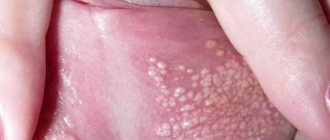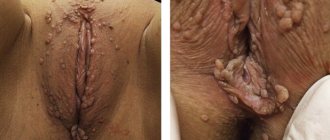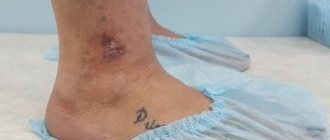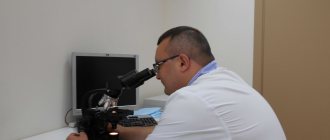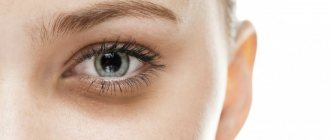A fairly common complaint that women go to the doctor with is acne on the labia.
Unfortunately, the term “pimple” is not a medical term and can include a number of very different conditions and manifestations.
In general, rashes on the genitals (pimples near the labia, in the groin and perianal area) are included in a separate group of symptoms.
Classified as genital lesions.
Pimples near the labia can be a sign of over a hundred different diseases.
Not all of which are related to sexually transmitted infections.
In addition, with some diseases, rashes can additionally be observed in the oral cavity and other parts of the body.
Rash elements of different types and manifestations are found with herpes, lice, impetigo, candidiasis, allergies, boils, STDs, etc.
As a result, even seemingly harmless lesions require referral to a specialist.
Regardless of which doctor, dermatovenerologist or gynecologist, will conduct an examination and prescribe the necessary studies and tests to identify the cause.
A correctly established diagnosis is the key to successfully getting rid of the problem.
Classification of rashes on the labia
Before answering the question of why acne appeared on the labia, for a correct assessment of the pathology process, it is important to be able to differentiate the elements that make up the rash.
According to dermatological terminology, primary ones are distinguished, appearing on unchanged skin.
And secondary elements, developing from primary ones.
Actually, in most situations, various types of acne on the labia belong specifically to the primary forms.
They are divided into cavity and cavityless.
Sometimes the transition from primary to secondary forms occurs very quickly.
In such a situation, knowledge of the specifics and patterns of transformation makes it possible to determine the type of previous education.
Primary elements include:
- A spot (artificial, non-inflammatory and inflammatory vascular, pigmented) is a limited change in skin color without cavities or elevations. Vascular formations of an inflammatory nature up to a centimeter in size are called roseola, from one to five centimeters - erythema. Examples include roseola syphilitica, erythematous variants of dermatitis, and toxicoderma. Possible secondary forms are secondary pigment spot, scale.
- A blister is a raised, cavity-free formation, the result of edema with acute inflammation in the papillary skin layer, which quickly appears/disappears. It can form due to urticaria, insect bites, and toxicoderma. Such itchy pimples on the labia are usually pink, less often whitish in the central zone, and may be accompanied by a burning sensation.
- Papules, otherwise known as nodules, are hollow, raised elements that usually pass without a trace. Such formations vary in size, depth, and can be inflammatory or non-inflammatory in nature. They may transform into cracks, scales, secondary pigment spots, lichenification (thickening, pigmentation disorders, deepening of the skin pattern). In some diseases, papules merge to form plaques.
- A tubercle is a hollow, raised, dense element up to a centimeter in size, which usually leads to the formation of scars and cicatricial atrophy. It can also develop into ulcers, growths, scales, and crusts. The formation lies deep in the skin and is observed in cases of tuberculosis, leishmaniasis, leprosy, and tertiary syphilis.
- A node is a hollow, raised element measuring over a centimeter (up to 10 cm). It may end without a trace or with the formation of a scar, ulcer, secondary pigment spot, or crust. Formed in the subcutaneous tissue. A subcutaneous pimple on the labia of inflammatory nature may turn out to be syphilitic gumma, a typical manifestation of tertiary syphilis. Non-inflammatory is formed due to the deposition of metabolic products (“pimple wen” on the labia) or as a result of neoplasms (lymphoma).
- A vesicle, otherwise known as a vesicle, is a cavitary single- or multi-chambered elevated formation, up to 5 mm in diameter, with a tire and a bottom. On the labia with genital herpes, watery pimples with serous contents appear on erythematous skin. Also, blisters on the labia are filled with serous-hemorrhagic contents (blood pimples). When the vesicles are opened, weeping erosions, scales, crusts, and secondary pigment spots may appear, but usually in the end there are no traces left on the skin.
- Bubble, bulla - differs in size from the bubble (its radius exceeds a quarter of a centimeter, and can even reach several centimeters). Resolves without a trace or with scarring. It is also possible to form erosions, scales, crusts, growths and age spots.
- Pustule, abscess - a cavitary deep or superficial raised formation with purulent contents (a pimple with pus is found on the labia). There are follicular, predominantly staphylococcal in nature, and non-follicular (superficial - phlyctena, deep - ecthyma), usually streptococcal. They can develop into crusts, erosions, spots, scars, ulcers, and growths. Follicular pustules form in the hair follicle, appearing on the labia as characteristic yellow pimples.
Secondary elements:
- scale – loosened horn cells in the form of a layer
- crust – drying contents of primary formations
- crack - a violation of the integrity of the skin that occurs due to a decrease in elastic properties
- abrasion - mechanical damage to the surface layer of skin
- erosion - a defect within the surface layer that appears when formations with a cavity are opened
- ulcer – deep skin defect
- scar - the formation of new connective tissue during the healing of skin defects
- cicatricial atrophy - cicatricial transformation without previous skin damage
- lichenification – thickening, dryness, compaction, staining, deepening of the skin pattern
- vegetation - growth of a skin area in an area of prolonged inflammation
- hyper- and hypopigmentation – weakening/increasing coloration of a skin area
Causes of acne on the labia
There are several groups of diseases, the manifestation of which is acne on the labia (in adult women, in girls, in girls).
They can be triggered by infectious agents (bacteria, viruses, fungi), allergic reactions, autoimmune problems, tumor conditions.
Contribute to the appearance of a pimple on the labia:
- failure to comply with hygiene rules
- injury when shaving intimate areas, using irritants
- poor quality linen
- stress conditions, hypothermia, overheating
- decrease in the body’s defenses due to chronic pathology, pregnancy, due to taking certain medications, etc.
Psoriasis
Psoriasis is a chronic disease. The lesions appear as well-demarcated areas of bright red color with flakes of exfoliated skin.
The process can involve both individual areas of the penis and the entire skin of the perineum. The diagnosis is usually established after examination by a dermatologist (typical signs are the psoriatic triad, localization of plaques, progressive nature of the disease).
The treatment is combined, long-term, and includes mandatory correction of lifestyle and nutrition, local use of glucocorticoids, salicylates, ultraviolet radiation and other techniques.
Rice. 4 - Psoriatic rash on the penis
Blisters on the labia
Blisters appear at the sites of insect bites (fleas, lice, etc.).
They are characterized by itchy rashes, the severity of which depends on the type of insect and the sensitivity of the bitten person.
Scratching the elements can lead to infection.
Spontaneous urticaria appears as itchy, sometimes burning, blisters.
The state is called:
- taking certain medications
- eating certain foods
- concomitant diseases (chronic gastrointestinal pathologies, diabetes, leukemia, etc.)
- pathological pregnancy, menopause, etc.
The elements first have a pale pink color, which becomes white as the swelling increases.
Usually such blisters disappear within 24 hours.
Treatment of vulvitis
If you notice any alarming symptoms, you should immediately consult a doctor. Only a specialist can diagnose the cause and prescribe correct and quick treatment, including a set of measures: relieving inflammation, eliminating factors that are catalysts for the process.
The basis of treatment for vulvitis is the elimination of the causes of the inflammatory process and treatment of concomitant diseases, which may include diabetes mellitus (Diabetes mellītus), gonorrhea (Gonorrhoea), diphtheria (Diphtheria), helminthiasis. After receiving smear test data and checking the sensitivity of the infectious agent, the doctor can prescribe medication, most often antibacterial drugs. Vulvitis responds well to treatment with local remedies, which include all kinds of ointments, gels and suppositories.
In parallel, in the course of treatment of vaginitis, vitamin complexes can be prescribed, including vitamin A to effectively protect the epithelial layer, as well as vitamins E and C, known for their antioxidant properties.
To combat severe symptoms, other drugs may be prescribed:
- Antihistamines that help relieve itching.
- Hormonal, occurring in atrophic vulvitis in the postmenopausal period.
- Anesthetics that relieve pain.
In addition to the medications prescribed by your doctor, you can use Gynocomfort Restoring Gel. This product was created by specialists from the pharmaceutical company VERTEX and underwent clinical trials at the Department of Dermatovenerology with the clinic of the St. Petersburg State Medical University. During testing of the gel, it was proven that it is a very effective additional agent as part of the complex therapy of inflammatory processes of the female genital tract.
As additional therapeutic measures that can be used at home, it is worth mentioning warm baths with herbal infusion.
Chamomile, calendula, string, and comfrey have excellent anti-inflammatory properties.
Baths will help not only reduce inflammation, but also relieve symptoms such as itching, burning and pain.
Papules on the labia
Papules occur when:
- molluscum contagiosum
- secondary syphilis (characteristic is the absence of tangible symptoms - pain, itching, i.e. if a pimple hurts on the labia, this suggests another problem)
- Fox-Fordyce disease
- psoriasis
- folliculitis
- scabies
- lichen planus
- trichomycosis, etc.
Infection with molluscum contagiosum in adults occurs through sexual contact.
That is why the main place of localization of formations (unlike molluscum contagiosum in children) is the genitals and the areas around them.
In women, such a “pimple” is more often found on the labia majora, in the perianal area, and on the pubis.
The causative agent of the pathology is molluscum contagiosum virus type 2.
The incubation period varies from a couple of weeks to six months.
A typical element in women is a flesh-colored or pink rounded dense pimple on the labia, with a characteristic depression in the center of the nodule.
If an infected person accidentally or intentionally squeezes out a pimple of this kind, for example, on the labia, a white cheesy mass is released.
In some cases (often in HIV-infected people), a complication develops - the addition of a bacterial infection.
As a result, a “painful” pimple with pus and redness forms on the labia.
With relapse of secondary syphilis, papular syphilide often occurs.
These are densely elastic nodules in the genital area, anus, as well as on the palms and soles.
As a rule, such formations on the labia look like red pimples that are prone to cracking and peeling.
It is important to differentiate the disease from papular pseudosyphilis.
Then, due to hygienic violations, many pimples of a pale pink color, densely elastic consistency, similar to syphilides, form on the labia.
With Fox-Fordyce disease, women complain of severe itching, pimples on the labia, in the armpits, near the nipples, and on the pubis.
Such pimples on the outer labia are formed due to blockage of the ducts of the apocrine glands.
Quite often the condition worsens, the itching intensifies, and pimples on the labia grow before menstruation.
Interestingly, acne on the labia and other manifestations subside during pregnancy.
In postmenopause, regression of the disease can be expected.
In a situation where the labia is swollen, one pimple is located in pairs with another, there are characteristic scabies tracts, itching worsens at night, a diagnosis of scabies is likely.
With this pathology, scabious lymphoplasia can develop due to the body's response to the effects of waste products from mites.
That is, scabies looks like a hard pimple on the labia of considerable size.
A noticeable pinkish-red “blue” pimple with a purple, lilac tint on the labia is found in lichen planus, an autoimmune disease.
A pimple that appears on the labia after shaving is a manifestation of trichomycosis.
It is caused by aerobic corynobacteria in association with pigment-forming bacteria.
These are small pimples on the labia, usually yellow.
Less common, usually in tropical climates, are red and black pimples on the labia.
In the affected areas, sweat acquires a yellow color and a foul odor.
Papular rashes may be normal if:
- micropapillomatosis of the vulva
- seborrheic cysts (Fordyce granules)
- epidermal and pilar cysts
With micropapillomatosis of the vulva, the pimple is localized on the inner side of the labia.
Multiple symmetrical rashes (pinkish-white pimples) on the labia minora, rarely on the labia majora, occur during puberty.
The exact reason for their appearance is unknown.
A small soft pimple of the labia mucosa of a pinkish-flesh color is removed only for cosmetic purposes.
It is important to differentiate the formation from genital warts.
The characteristic distinguishing features are:
- symmetry of location (in condylomas it is chaotic)
- softness (condylomas are dense)
- no blanching in dough with acetic acid
An epidermal cyst is the most common cystic skin lesion.
It occurs when a cavity forms in the skin layer and fills it with horny masses and the production of the sebaceous glands.
Usually this is a single formation in the genital area, chest, face, upper back, neck.
The wall of the formation is thin and breaks easily.
If a pimple of this kind bursts on the labia, the cyst greatly increases in size and hurts.
A small epidermal cyst containing keratin is called a milia.
The formations look like white subcutaneous pimples with a predominant localization on the face.
In some cases, they appear on the labia and limbs.
They develop from the ducts of the sweat and sebaceous glands, hair follicles.
Seborrheic cysts are visible sebaceous glands, very small yellow-white formations.
Non-inflammatory papules with a villous surface, so-called. papulo-verrucous rashes are a sign of:
- anogenital warts
- condylomas lata with secondary syphilis
- bowenoid papulosis, etc.
How to treat genital herpes in women?
It must be emphasized that it is necessary to treat genital herpes in women only after consultation with a doctor.
It should also be noted that currently there are no drugs for herpes that can remove the virus from the human body and lead to a complete cure. Therefore, treatment is aimed at suppressing the virus in the body and, most importantly, restoring immunity.
Genital herpes in women is treated to:
- prevent complications
- prevent relapse of the disease,
- to prevent transmission of the virus and infection of children, loved ones, sexual partners, work colleagues, etc.,
- prevent a decrease in quality of life,
- prevent further weakening of immunity.
Drug treatment comes down to 3 stages:
- suppressing an outbreak or relapse of the disease with the help of antiviral (chemo) drugs, interferons;
- restoration of the body's defenses - immunity with the help of general strengthening agents, probiotics, vitamins, interferons;
- vaccination with the antiherpetic vaccine "Vitagerpavak".
How to treat genital herpes?
Effective antiviral chemotherapy drugs for herpes are drugs such as acyclovir, as well as its more effective second-generation derivatives: valacyclovir, Valtrex, famciclovir, penciclovir. These drugs have a comparable mechanism of action and clinical effectiveness, they help to quickly and effectively reduce the severity of symptoms, subjective sensations, and the duration of relapse, but they cannot cure the infection (completely remove the virus from the body).
Acyclovir and its analogues act only on the active herpes virus, but do not affect viruses that are in a latent state. A common disadvantage of acyclovir-containing drugs is the inability to prevent relapses of the disease and infection with a related type of virus and a negative effect on the immune system. Further suppression of the immune system leads to the emergence of resistant strains of the virus. Antiviral chemotherapy drugs are used occasionally in a short course (5-10 days) for primary herpes or for relapses of herpes.
For herpes, it is possible to use antiviral agents topically. This helps lead to a significant reduction in the time of appearance and regression of rashes due to the high bioavailability of active substances at the site of the lesion. Acyclovir (ointment, cream) and the new drug Penciclovir (1% cream Fenistil® Pencivir) have proven themselves well. The effectiveness of Fenistil® Pentsivir is 20–30% higher than acyclovir-based cream. Fenistil® Pencivir cream can be used in patients over 12 years of age. If there is resistance to acyclovir-containing drugs, antiviral drugs with a different mechanism of action (foscarnet, isoprinosine, panavir, aloferon, etc.) are used.
During pregnancy, for the purpose of treatment and prevention of recurrence of genital herpes and infection of the fetus, herpes medications in tablets (Acyclovir, tablets) are prescribed starting from the second trimester of pregnancy in consultation with a doctor.
The presence of side effects from the use of chemotherapy drugs contributed to the introduction of modern, effective and harmless drugs - interferon drugs - into the treatment of herpes. The ability of interferons to suppress the multiplication of a virus in the human body explains the need for their use (giaferon, viferon, genferon, etc.). The effectiveness of Giaferon is 30% higher than the effectiveness of other drugs in this group, because also contains hyaluronic acid, an independent immunomodulator. Their use as antiviral agents and immunomodulators, stopping relapses of the disease and correcting immunity, allows them to be effectively used in the treatment of pregnant women and nursing mothers, and to prevent intrauterine infection of the fetus.
Is it necessary to talk about the importance of treatment aimed at strengthening defenses and preventing relapse of genital herpes? In cases of moderate and severe forms of the disease (relapse once every 3 months or more often), to increase the effectiveness of treatment, treatment regimens, along with antiviral drugs, include immunocorrective drugs: immunomodulators, interferons, vitamins, restoratives, immunoglobulins and probiotics. It should be noted that immunotherapy leads to deep remission, i.e. to restore immunity, allows you to shorten the duration of treatment, reduce the toxic effect of chemotherapy drugs on the body, prevent the formation of resistance to them and lead to deep remission, i.e. to restore immunity.
To increase the effectiveness of treatment of herpes virus infection, a group of virologists and infectious disease specialists led by Doctor of Medical Sciences, Prof. V.A. Isakov* developed a step-by-step, comprehensive method for treating and preventing recurrence of the disease using the drugs described above:
- Stage 1 of treatment – relief of the acute period of the disease (chemotherapy, interferons),
- Stage 2 – restorative therapy, immunocorrection,
- Stage 3 – specific immunoprophylaxis – vaccination with the antiherpetic vaccine Vitagerpavak,
- Stage 4 – clinical observation.
Chemotherapy drugs and interferons only suppress the virus in its active stage, but the vaccine treats, normalizing immune defense, and therefore belongs to the group of therapeutic vaccines.
It should be noted that special attention is paid to restoring the body’s immunological reactivity with the help of medication and anti-relapse treatment using general tonic agents, vitamins, interferons, probiotics, and immunoglabulins. Immunoprophylaxis at the final stage of treatment with the antiherpetic vaccine Vitagerpavak allows you to restore specific antiviral immunity, i.e. achieve suppression of the virus and normalization of immunity, leading to long-term (many years) remissions. This technique was called the “Russian method of treatment” in the West.
It is important to remember and consider that:
- Herpetic infections are a consequence of impaired immunity.
- In mild forms of the disease (exacerbation no more than once every 3 months), there is slight immunosuppression. Therefore, vaccination can be carried out immediately, without restorative treatment (7-10 days after healing of herpetic eruptions with an interval of 7-10 days, in the amount of 5 injections).
- In moderate and severe forms of the disease (recurrence once every 3 months or more often), it is necessary to eliminate severe immunosuppression by prescribing general tonic drugs, vitamins, immunomodulators, probiotics, and only then begin vaccination (10 days after healing of the rash with an interval of 10 days in the amount of 5 injections). It is necessary to carry out 4 courses of vaccination with an interval of 3 months under the cover of Giaferon (1 suppository 2 times a day rectally - 5 days).
The effectiveness of treatment is more than 86%, which is confirmed by the results of its use for 12 years and numerous studies of effectiveness conducted by leading scientists and clinicians of the Russian Federation in various fields.
The Vitagerpavak vaccine is used during the period of remission of the disease. The purpose of vaccination is to activate cellular immunity, i.e. its immunocorrection.
The use of the Vitagerpavac vaccine has a number of advantages over antiherpetic drugs, as evidenced by studies conducted in leading medical institutions in Russia.
Prof. N.S. Potekaev** and Associate Professor M.A. Samgin (Department of Skin and Venereal Diseases of the I.M. Sechenov First Moscow State Medical University) studied the effectiveness of the Vitagerpavak vaccine in 233 patients with recurrent herpes, including herpes on the lips . The treatment was the Vitagerpavac vaccine. It was shown that regular vaccination led to an increase in the period of remission to 1-3 years. Over time, 5 years after regular 4-year vaccination, 88 patients were examined: a positive effect was noted in 72% of patients with a recurrent form of herpes; complete cure - in 42 patients, significant improvement - in 24 patients.
In another study, the vaccine was studied in 3,000 patients with frequently recurrent forms of herpesvirus. Dynamic observation of patients over a period of 3 to 5 years showed that vaccine therapy led to a complete cessation of disease relapses in 1890 patients (63%), to a decrease in the frequency of relapses in 810 people. (27%). The lack of effect was detected in 240 (8%) patients (MD, professor, head of the department of skin and venereal diseases of the RUDN University, A.L. Tishchenko).
In a study conducted by Prof. Barinsky I.F. et al., **** at the Federal State Budgetary Institution “Research Institute of Virology named after. DI. Ivanovsky" of the Ministry of Health of Russia, Moscow, it was shown that in patients with frequently recurrent herpes, including herpes on the lips, 6 months after vaccine therapy (Vitagerpavak) a significant improvement (increase in the inter-relapse period by 3 times) was noted in 19 (31.1%) patients, improvement (increase in remission by 1.5–2 times) - in 35 patients (57.3%) and only in 7 (11.6%) patients the therapeutic effect was weak or absent. As a result of vaccination, the majority of patients (38 people) stopped treatment due to improvement. In 52% (20 patients) of them, clinical symptoms of recurrent herpes were completely absent.
Prof. Barinsky I.F. et al.,*** also conducted a comparative study of the effectiveness of the vaccine alone and in combination with the immunostimulant Giaferon in patients with frequently recurrent herpes, including herpes on the lips. The means of treating herpes were: the polyvaccine Vitagerpavak and the immunostimulant Giaferon. Patients of group 1 (28 people) were prescribed the Vitagerpavac polyvaccine in combination with an immunostimulant. Patients of group 2 (25 people) received only the vaccine. Efficacy was assessed by reducing the duration and intensity of clinical manifestations of genital herpes during relapse and increasing the duration of the interval between relapses. When using the vaccine in combination with Giaferon, a positive result was noted in more than 96% of cases, when using one vaccine - in 84% of cases. The conducted studies demonstrated the advantage of the combined method of vaccine therapy and the immunostimulant “Giaferon”. The proposed combined treatment regimen made it possible to prevent relapses of herpes, including herpes on the lips.
Dynamics of clinical parameters in patients with recurrent HH during vaccine therapy
| Clinical indicators | Before vaccine therapy | After vaccine therapy |
| Duration of remission | 2 months | 6 months in 36 (59.0%) patients |
| Relapse rate | 5–10 times a year | 2–3 times a year |
| Duration of relapse | 3–8 days | 2–3 days |
Of interest are the results of a study using the Vitagerpavac vaccine conducted by Prof. A.A. Kasparova et al. (Research Institute of Eye Diseases of the Russian Academy of Medical Sciences), with the participation of patients with ophthalmoherpes caused by the herpes simplex virus. Of 114 patients with ophthalmoherpes with frequently recurrent forms, relapses of the disease completely stopped in 71 patients (63%), their frequency became significantly less frequent in 32 (27%) and did not change in only 11 people. (10 %). Analysis of the results revealed a 5-fold reduction in the frequency of relapses and a 3.2-fold reduction in the duration of relapses per 1 patient suffering from herpetic keratitis, keratoiridocyclitis and iridocyclitis. When studying the blood of patients with herpes using PCR and MFA methods, it was revealed that the use of an inactivated vaccine was accompanied by the elimination of viremia.
In the above-mentioned studies, it was also shown that vaccination was accompanied by a 3-4 times increase in specific reactions of T-cell immunity, against the background of a constant level of B-cell immunity reactions. The study of T-cell immunity reactions showed an increase in the specific T-killer activity of lymphocytes and the activity of NK cells. Vaccination contributed to the cessation of viremia both after the end of vaccination and in long-term follow-up (after 6 months). Vaccination using Vitagerpavak led to a pronounced immunocorrective effect, reducing immune disorders from degrees 3 and 2 to 1. After 6 months after vaccination, immune disorders corresponded to the 1st degree.
The above results of long-term studies of the Vitagerpavak vaccine indicate the reliable effectiveness of the vaccine in preventing relapses of herpes infections against the background of activation of cellular immunity reactions and specific desensitization.
If you are faced with the question “how to get rid of genital herpes”, and other methods have proven to be ineffective, then you should definitely pay attention to this method of preventing relapses of the disease.
How to treat genital herpes using the Vitagerpavac vaccine?
The basic vaccination regimen using the Vitagerpavac vaccine: 0.2 ml of the vaccine is injected intradermally into the flexor surface of the forearm. The vaccination cycle consists of 5 injections, which are carried out at intervals of 7-10 days. For a lasting preventive effect, repeated courses of vaccination are necessary. In case of herpetic rashes, the intervals between injections should be increased to 14 days. After 6 months, revaccination is carried out (5 injections). In severe forms of the disease, revaccination is carried out after three months, 4 courses over 1.5 - 2 years.
Where can I get vaccinated?
Vaccine for the prevention of chronic herpes virus infection.
1 package – full course of treatment.
Vaccination course: 5 injections, given at intervals of 7-10 days. Store at a temperature of 2-8 ºС. The drug can be transported at a temperature of 9-18 ºС, but not more than 3 days.
To increase the effectiveness of treatment and prevent relapses of genital herpes in people with weakened immune systems, along with drug treatment, it is necessary to pay attention to strengthening the body's defenses. Particular attention should also be paid to the prevention of factors that contribute to decreased immunity and exacerbation of herpes infection.
Briefly about the Vitagerpavac vaccine:
Compound:
— The drug is a lyophilisate for preparing a solution for intradermal administration — Contains specific inactivated antigens of herpes simplex virus types I and II grown on a continuous cell line VERO, acceptable by WHO as a substrate for the production of vaccines
Indications:
- Patients with CGI are subject to vaccination.
- Preparing women with a history of recurrent chronic herpetic infection for pregnancy.
- HIV-infected patients in stages 1-2 of the disease.
Contraindications to the use of the vaccine:
- Active stage of herpes
- Acute infectious and non-infectious diseases
- Chronic diseases in the stage of exacerbation or decompensation
- Malignant neoplasms
- Pregnancy
- Presence of active AIDS symptoms
Genital warts on the labia
Anogenital warts, also called condylomas acuminata, are caused by the human papillomavirus.
They are formations of a characteristic appearance: their lobed structure makes them look like a cauliflower stalk.
Such a pimple forms inside the labia, near the vestibule of the vagina, anus.
There are also varieties with a smooth surface and the color of raw meat (papular warts).
Separately, there is a giant Buschke-Levenshtein condyloma, which can form during pregnancy or in people with reduced immunity.
It is important to differentiate genital warts from broad ones, manifestations of secondary syphilis.
The latter are a dense purple, red dark pimple with a wide base on the labia.
Bowenoid papulosis is a relatively rare disease.
It also occurs when infected during sexual contact with the human papillomavirus (type 16, high cancer risk group).
The main complaint of patients is that a flesh-colored, brown or red pimple has appeared in the pubic area, inguinal folds, perianal area, and on the labia.
Gradually, such papules merge into plaques with a warty surface.
Approximately 3% of cases of the disease result in malignancy.
Circinar balanitis
It occurs in 12-70% of men with Reiter's syndrome (inflammation of the urethra, joints, conjunctiva of the eye due to chlamydia) and is characterized by the appearance of well-demarcated, moist, red spots with an uneven contour on the head of the penis.
In circumcision patients, the lesions have a dry, scaly surface and can mimic psoriasis lesions. Most often, the skin around the external opening of the urethra is involved in the pathological process.
Rice. 3 – Circinar balanitis
Plaques on the labia
If a pimple appears on the labia, its size exceeds 1 cm, and in some cases, the skin in the affected area is thinned and whitened, we can talk about such primary elements as plaques.
Plaque lesions in women are typical for the following pathologies:
- neurodermatitis
- seborrheic keratosis
- lichen planus
- lupus erythematosus
- atopic dermatitis
- vulvitis candidiasis
- psoriasis
- Bowen's disease
- lichen sclerosus, etc.
With a disease such as candidal vulvitis (thrush), pimples on the labia and mucous membranes accompany the main manifestations.
These are curdled moderate/heavy discharge, swelling, redness.
Itching, which intensifies after sexual contact, a hygienic shower, during sleep, irritation, and a burning sensation in the perigenital area are also characteristic.
The problem is caused by the activity of yeast-like fungi of the genus Candida.
Lichen sclerosus - otherwise white spot disease, lichen sclerosus, vulvar kraurosis.
It appears in the form of clearly defined light spots, plaques, papules (“white pimples”) on the labia, in the inguinal folds, and vulva.
The formation of bloody blisters and erosions is possible.
Scarring often leads to fusion of the labia minora.
Bowen's disease is an intraepidermal formation (carcinoma) in the form of a sharply limited plaque with an uneven surface.
Usually detected in old age, it can develop into squamous cell carcinoma.
Contact dermatitis
The appearance of red dots on the head may be a sign of contact dermatitis (simple or allergic). Allergies can develop to almost any known chemical substance.
Most often, the reaction occurs to spermicides (components in contraceptives), lubricants, washing powders, men's shower gels, and soap. Contact dermatitis can also develop when wearing tight, synthetic underwear, after violent or prolonged sex (especially if the vulva and vagina of the partner are dry).
In addition to redness and a small rash, a man is bothered by moderate pain, dry skin and swelling. The described symptoms disappear by limiting contact with the allergen, prescribing sexual rest and prescribing reparative ointments (Dexpanthenol, Bepanten). Allergic reactions are quickly relieved by ointments with glucocorticoids (Advantan, Elokom, etc.)
Pustules on the labia
Usually a pustule, otherwise a purulent pimple on the labia, does not exist for a very long period and may not even be noticed by the patient.
Superficial pustules quickly turn into crusts, while deep ones can form ulcers/erosions.
A group of dermatoses based on purulent inflammation of the skin is called pyoderma.
Pustular lesions are characteristic of:
- folliculitis
- impetigo
- hidradenitis
- syphiloid Sevestra-Jacquet and others.
Impetigo is a small superficial abscess with a convex red border.
The most common causes of the condition are staphylococci (80% of episodes) and streptococci.
A type of streptococcal impetigo in infants is post-erosive syphiloid Sevestra-Jaquet.
A problem arises with poor hygienic care for well-fed children as a result of the irritating effect of urine and feces.
Folliculitis is an inflammation of the hair follicle caused by bacteria, fungi, etc.
Deep folliculitis is called a boil.
Boils are inflamed, swollen pimples on the labia, cone-shaped with a necrotic core.
After the rod is separated, an ulcerative lesion develops in its place.
The recurrent appearance of numerous boils occurs with furunculosis.
A conglomerate of boils is called a carbuncle; it is a dense, up to 10 cm in diameter, node with pus.
Hidradenitis is a purulent inflammatory lesion of the apocrine glands that develops in the genital area, navel, anus, nipples, and axillary area.
In an infant, papulo-erosive streptoderma may appear on the labia, skin of the perineum, buttocks, and thighs - dense bluish-red pimples.
Plasmacytic (Zoon) balanitis
Rice. 2 – Zoon-balanitis
A benign non-venereal disease of the penis, which is characterized by the appearance of a single red-orange, well-circumscribed plaque on the head. It most often develops in middle-aged and elderly men who have not undergone circumcision.
The exact cause of the pathology has not been established, but the main predisposing factors are phimosis, constant irritation and mechanical damage to the skin.
Apart from the plaque, a man may not be bothered by anything; pain and burning during urination are less likely to occur. Circumcision eliminates the manifestations; local ointments based on glucocorticosteroids and 5% imiquimod are also used in treatment.
Vesicles on the labia
Blistering formations, similar in appearance to “cold” pimples, on the labia and in the area of the vestibule of the vagina.
They are a sign of a viral infection – genital herpes.
This disease is caused by the herpes simplex virus and is prone to recurrence.
The typical form of the disease is characterized by itching, tingling, burning, and pain that precede the appearance of rashes.
The condition ends with the formation of crusts and areas of hyperpigmentation.
Chickenpox is an extremely contagious acute primary infection caused by a virus.
It is characterized by progressive rashes that appear in successive waves.
The disease is difficult to tolerate in adults and adolescents, newborns, and people with immunodeficiency.
In this case, rashes appear not only on the face and torso, but also in the mouth, on the labia.
They are a mixture of various elements, among which one can simultaneously identify itchy purulent large pimples, blisters, papules, and crusts.
Patients often complain that due to the fact that there are pimples on the mucous membrane and labia, it is painful to write and perform hygiene procedures.
Diagnostics
The diagnosis is made by a doctor based on the patient’s complaints and examination, during which a characteristic rash and enlarged lymph nodes can be detected. If an external examination does not reveal a rash, the doctor takes material for laboratory tests.
In addition, you need to know how to detect genital herpes using laboratory methods. Can:
- Determine the disease using the PCR method during the period of relapse (the most effective), which determines not only the presence of the virus in the body, but also its type. Subject to sterility and temperature conditions, material taken from the site of the rash allows you to obtain results within 5 hours;
- Identify antibodies to the virus by conducting blood tests;
- Identify the virus by examining material taken from the location of the rash;
- Conduct an enzyme-linked immunosorbent assay, which determines the presence of antibodies and evaluates the patient's immunity.
Since there are diseases similar to genital herpes in their manifestations (ulcers and erosions on the genitals), self-medication should not be done.
Herpes or so-called stomatitis on the genitals resembles:
- Chancroid, sexually transmitted but rare in Europe and Asia;
- Erosion resulting from trauma;
- Syphilis.
Since the presence of antibodies alone cannot serve as a basis for the diagnosis of “genital herpes” (in women, the presence of antibodies to type 2 herpes is more likely, and antibodies are formed by 6-12 weeks after infection), it is additionally necessary to isolate the virus or use the PCR method.
Other lesions on the labia
Bulla
A bulla is a huge pimple on the labia, a blister with a diameter of more than 5 mm.
Such formations in most situations are a symptom of serious skin lesions - bullous dermatoses.
For example, bullous pemphigoid is an autoimmune skin disease.
With it, itchy spots and papules first appear, and in their place blisters later develop, gradually turning into erosions.
tubercles
Tuberous dermatoses are rare.
Tend to progress to ulcerative formations with subsequent scarring.
They can be detected in cutaneous tuberculosis, pyogenic granuloma and tertiary forms of syphilis.
Nodes
Nodes are deeply located formations of dense consistency.
They do not exceed five centimeters in diameter and are rarely localized in the genital area.
Diseases manifested by the formation of nodes include:
- lymphangioma is a benign tumor that arises from the lymphatic vessels
- hidradenoma – benign tumor of the sweat gland
- lipoma – benign tumor of adipose tissue
- tertiary syphilis, etc.
A separate problem is pathologies in the area of the Bartholin glands.
They are located symmetrically at the base of the labia majora.
When the lumen of the gland is blocked, secretions accumulate in it and a cyst forms.
If infectious agents penetrate into the lumen, the development of bartholinitis (inflammation of the gland) and abscess (painful node with a purulent cavity) is possible.
Squamous cell skin cancer of the penis
This form accounts for 95% of all malignant tumors of the penis. Peak incidence is 40-50 years. Risk factors are phimosis, balanitis obliterans and other precancerous conditions, frequent change of sexual partners, infection with HPV types 16 and 18.
Squamous cell carcinoma practically does not occur in men after circumcision. Red, compacted areas with unclear contours may appear on the skin of the head; in some cases, the tumor protrudes significantly above the skin.
Tumor germination is accompanied by superficial ulceration and bleeding. Examination and treatment are prescribed by an oncologist. The treatment regimen depends on the stage of the tumor and may include surgical excision, radiation, chemotherapy, or laser removal of the tumor.
Rice. 6 – Squamous cell carcinoma of the head of the penis


